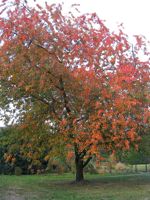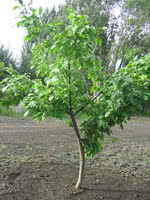Mon-Fri 9am - 5pm Mountain time
Black Cherry vs Mustang Cherry Plum
Prunus serotina
Prunus x Jefchum
NOT AVAILABLE THIS SEASON - MIGHT RETURN
Black Cherry is common in eastern North America but a rare find elsewhere. This tree is shade tolerant and is often found in old fields, forest openings, and along fencerows.
The fruit is edible and is commonly used to flavor rum and brandy. It is also edible and often eaten fresh or used in wine or jelly. Black Cherry trees typically begin producing fruit when they are 10 years of age.
Black Cherry wood is a rich reddish-brown color and is strong, making it valued in cabinetry and woodworking. It is often used in reclamation as well.
The leaves can poison livestock as they contain cyanide derivatives and precursors. However, many have noted that deer still seem to browse their trees with impunity and birds and other animals eat the fruit when available.
Mustang Cherry Plum is a cherry-plum hybrid. They are known for their fragrant white flowers in spring and sweet fruit in late August. Mustang Cherry Plums are about one inch in diameter and they have a strong cherry taste. This plant is small enough to fit in moderately sized yards.
Because of Mustang Cherry Plum's genetics and cold hardiness, it is popular for grafting and as a rootstock.
For fruit production, it needs to be planted with another variety for cross-pollination. Canada Plum and American Plum are considered universal pollinizers.
Black Cherry Quick Facts
Mustang Cherry Plum Quick Facts
Toxicity: bark and wilted leaves toxic to livestock

